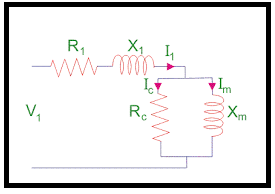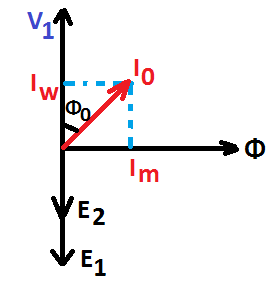The current drawn by the induction motor when it is not coupled to the driven equipment is called the no-load current of the motor. The equivalent circuit of an induction motor at no load is given below.

The no-load current produces the magnetic field in the motor. There are two parts of no-load current.
- Magnetizing component of the current(Im)
- Loss components( Hysteresis and eddy current loss)-Ic
The no-load current(Io) is the vector sum of the magnetizing current(Im) and no-load loss components current(Iw).

An induction motor draws the magnetizing current(Im) to set up the magnetic flux in the air gap. The magnetizing current is responsible for setting up air gap power in the induction motor. The loss component current(Iw) is drawn by the motor to meet the eddy current loss and hysteresis loss. The loss component current is independent of the load current, and thus, the loss component current(Iw) is constant for a particular motor. The no-load current(Io) is a fairly constant current and does not change with increased loading on the motor.
If the magnetizing current of the induction motor is 5 amperes and the core loss current is 2 amperes, then no load current of the motor is ;
The higher magnetizing current leads to the poor power factor of an induction motor.
However, the higher magnetizing current leads to better overloading capacity of the motor. The magnetizing current of the motor increases with an increase in the number of poles of the motor. The no-load current has a prominent effect on the performance of the induction motor. Energy-efficient motors have lower no-load currents than conventional motors. The no-load current of the induction motor varies from 30 to 60 % of its full load current.